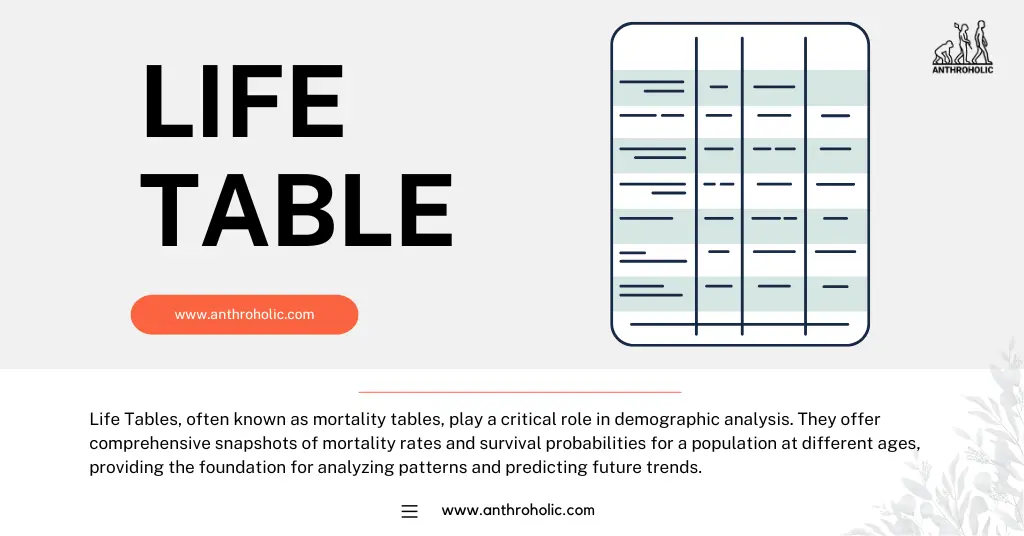AI Answer Evaluation Platform Live Now. Try Free Answer Evaluation Now
Life Table
Life Tables, often known as mortality tables, play a critical role in demographic analysis. They offer comprehensive snapshots of mortality rates and survival probabilities for a population at different ages, providing the foundation for analyzing patterns and predicting future trends [1]. This article presents an in-depth exploration of life tables, their key components, their uses, and how they are constructed.

Components of a Life Table
Life tables encompass four key components [2]:
- Age (x): Denotes the age of the population group.
- Number of Survivors (l_x): Shows the number of individuals surviving to age x.
- Death Rate (q_x): Signifies the proportion of individuals of age x expected to die before reaching age x+1.
- Life Expectancy (e_x): Reflects the average number of additional years a person of age x is expected to live.
A simplistic representation of life table components is shown below.
| Age(x) | Number of Survivors(l_x) | Death Rate(q_x) | Life Expectancy(e_x) |
|---|---|---|---|
| 0 | 100,000 | 0.002 | 78.8 |
| 1 | 99,800 | 0.001 | 78.1 |
| 2 | 99,700 | 0.001 | 77.2 |
| … | … | … | … |
Life Table Construction
Creating a life table involves multiple steps [3]:
- Collection of Death Rates Data: The process begins by collecting age-specific mortality data for a particular population.
- Calculating the Number of Survivors: Start with an initial cohort size (usually 100,000 for ease of calculation) and subtract the number of deaths in each age group to get the number of survivors at each age.
- Calculating Death Rates: Divide the number of deaths at each age by the number of survivors at the beginning of the age interval.
- Estimating Life Expectancy: It’s computed by taking the sum of the number of years lived by each individual in the cohort and dividing it by the initial cohort size.
Uses of Life Tables
Life tables find significant application in:
- Demography: They enable demographic analysis of the age structure, mortality trends, and life expectancy within a population [4].
- Healthcare Planning: They help in identifying disease prevalence and prioritizing healthcare resources [5].
- Insurance and Pension Industry: Life tables are critical in determining premiums and pension annuity rates based on mortality risk [6].
- Population Studies and Social Research: Life tables are used in analyzing social phenomena like birth rates, fertility rates, and the impact of policies on population dynamics [7].
Life Tables in Actuarial Science
The insurance industry and pension plans heavily rely on life tables to manage risk and determine premiums [8]. Actuaries use life tables to calculate the likelihood of a policyholder surviving to each age, which directly impacts the pricing of life insurance policies. Similarly, pension plan administrators use life tables to estimate how long retirees will collect benefits, assisting in the assessment of the financial stability of the plan.
Life Tables in Public Health
Life tables play a pivotal role in public health planning and epidemiology [9]. They provide an understanding of mortality and survival rates for different age groups, guiding resource allocation, and policy formulation. Life tables also assist in identifying and addressing health disparities by providing a clear picture of the population’s health status, making them instrumental in health impact assessments.
Types of Life Tables
There are two types of life tables: Cohort (or generation) life tables and Period (or current) life tables.
- Cohort Life Tables: They track the mortality experience of a particular birth cohort (all individuals born in a particular year), from the time of their birth through their consequent ages [10]. This type of table showcases the actual historical record of mortality rates affecting a cohort.
- Period Life Tables: They represent mortality rates among a hypothetical cohort assumed to be alive at the start of a given period and subject to the age-specific mortality rates observed during that period [11]. They provide an excellent snapshot of a population’s mortality at a specific point in time.
Limitations of Life Tables
Despite their utility, life tables have limitations [12]:
- They do not account for the impact of future changes in mortality trends.
- Life tables, especially cohort ones, may not fully capture the mortality experience of sub-groups within the population.
- They may oversimplify complex demographic structures, leading to potential misinterpretation of data.
Conclusion
Life tables serve as powerful analytical tools in understanding mortality patterns and demographic dynamics, critical in fields ranging from healthcare to insurance. Their comprehensive nature allows for an effective and efficient study of populations, providing insights that drive policy and decision-making processes.
References
[1] Preston, S., Heuveline, P., & Guillot, M. (2000). Demography: Measuring and Modeling Population Processes. Oxford: Blackwell Publishers. https://gwern.net/doc/statistics/2001-preston-demography.pdf
[2] Vaupel, J. W., Manton, K. G., & Stallard, E. (1979). The Impact of Heterogeneity in Individual Frailty on the Dynamics of Mortality. Demography, 16(3), 439-454.
[3] Wachter, K. W. (2014). Essential Demographic Methods. Harvard University Press.
[4] Pollard, A. H., Yusuf, F., & Pollard, G. N. (1990). Demographic Techniques. Pergamon Press.
[5] Harper, S. (2014). Economic and social implications of aging societies. Science, 346(6209), 587-591.
[6] Bowers, N. L., Gerber, H. U., Hickman, J. C., Jones, D. A., & Nesbitt, C. J. (1997). Actuarial Mathematics. The Society of Actuaries.
[7] Rowland, D. T. (2003). Demographic methods and concepts. Oxford university press.
[8] Dickson, D. C., Hardy, M., & Waters, H. R. (2009). Actuarial mathematics for life contingent risks. Cambridge University Press.
[9] Murray, C. J., & Lopez, A. D. (1996). The global burden of disease: a comprehensive assessment of mortality and disability from diseases, injuries, and risk factors in 1990 and projected to 2020. Harvard University Press.
[10] Keyfitz, N., & Caswell, H. (2005). Applied Mathematical Demography. Springer.
[11] Horiuchi, S., & Wilmoth, J. R. (1997). Age patterns of the life table aging rate for major causes of death in Japan, 1951-1990. The Journals of Gerontology Series A: Biological Sciences and Medical Sciences, 52A(1), B67-B77.
[12] Shryock, H. S., Siegel, J. S., & Associates. (1973). The methods and materials of demography. US Bureau of the Census.




